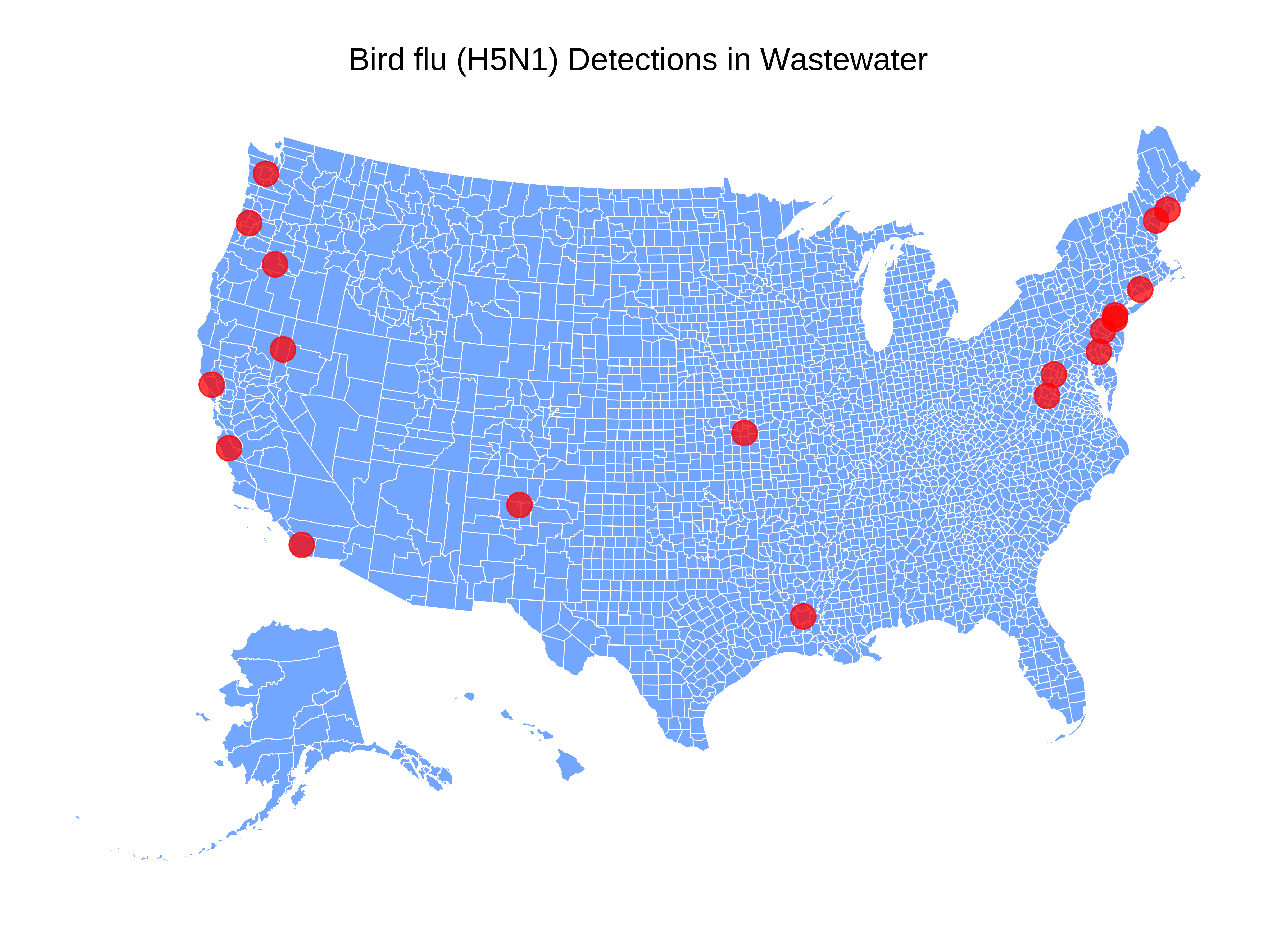At Biobot, we analyze wastewater across the country for various infectious disease pathogens....

Respiratory Virus Risk Reports
Comprehensive Insights for COVID-19, Influenza, and RSV
COVID-19, Influenza, and RSV Wastewater Monitoring in the U.S. | Week of May 20, 2024
Throughout the respiratory season, we analyze wastewater for the presence of respiratory syncytial virus (RSV) and influenza virus (types A and B). Together with COVID-19, these three pathogens are outsized contributors to our seasonal respiratory illness burden. In this data series, we’ll guide you through the wealth of data we’ve gathered from our Biobot Network of national sampling sites, aiming to shed light on emerging trends in respiratory virus activity and community viral load. Our goal is to equip you with information to make informed decisions.
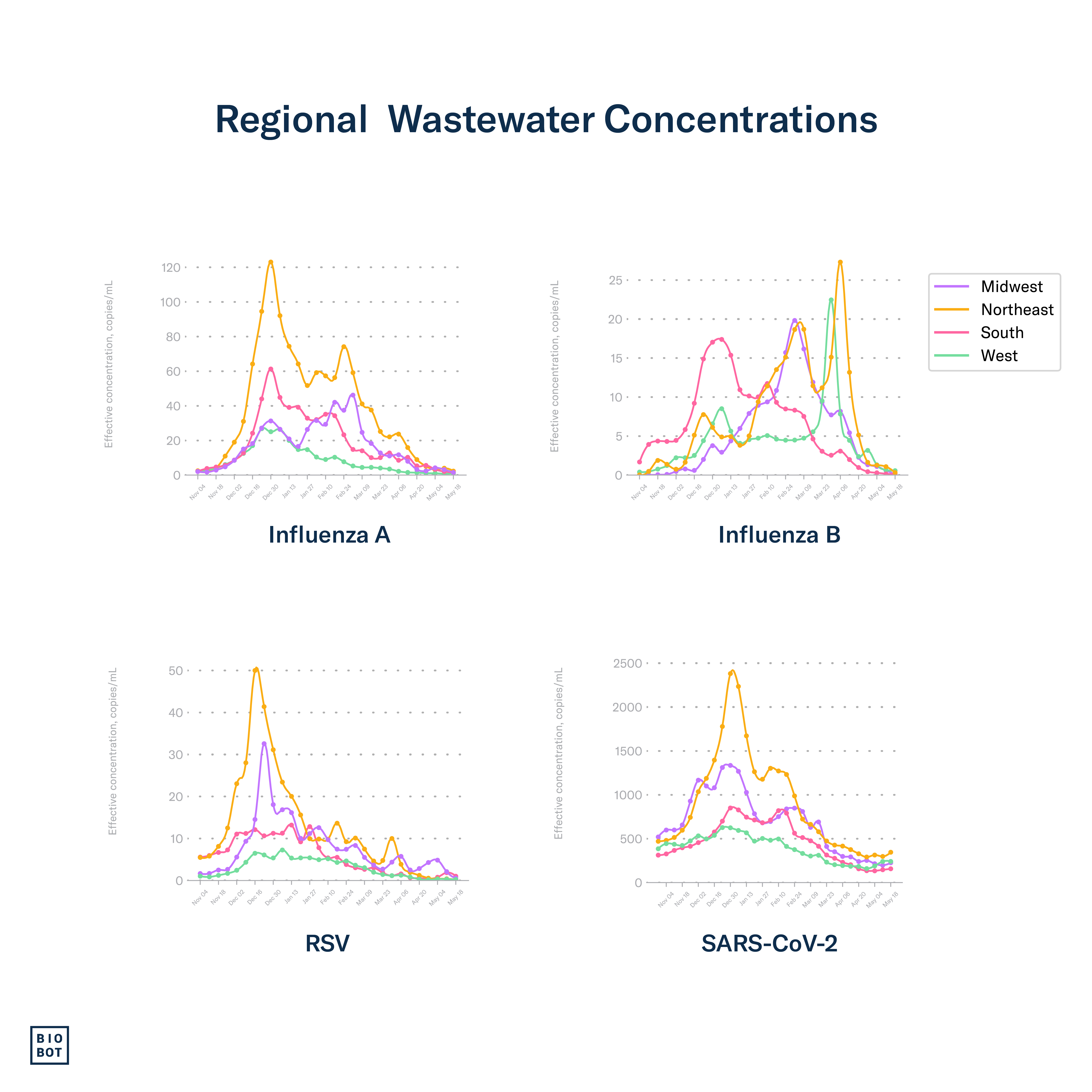
Data Note: Samples are collected from participating locations, and processed by our lab team on a rolling basis. Each point on the figure represents the weekly average concentration, from Sunday – Saturday (corresponding to the MMWR week), aligned to that week’s Saturday.
Contributors

Marisa Donnelly, PhD
Public Health Partnerships Epidemiologist
Previous Risk Reports
Summary: Week of 5/20/24
NOTE: We initially reported that SARS-CoV-2 levels were holding steady in week 20, but after an error was noticed, we have corrected the figures below, as well as this week’s report narrative. Thank you to our dedicated readers for pointing this out!
——
We continue to monitor the rapidly evolving H5N1 influenza virus situation. As we do, a quick reminder that Biobot’s influenza A assay detects the H5N1 influenza subtype, which is an influenza A virus, but does not distinguish between the different subtypes of influenza A (e.g. H5N1 vs H1N1).
Thankfully, we have not seen widespread increases in influenza A concentrations. Data through week 20 (May 18th) also indicate that there is minimal influenza activity in the four US regions. We want to highlight are some important points about the role of Biobot’s wastewater data in understanding the current circulation/risk of H5N1:
- At this point, we cannot determine if these upticks are due to seasonal influenza A virus or if H5N1 could be playing a role in the increase.
- Biobot is currently testing for influenza A in 7 out of the 9 states with positive dairy herds (Texas, New Mexico, Kansas, Idaho, Ohio, North Carolina, and South Dakota), among several other states across the country.
- Our current assays do not distinguish between human infections and infected animals that shed into the wastewater system.
This situation is rapidly evolving and our team will continue to closely monitor H5N1. We will provide any additional information as it becomes relevant or available via Twitter and here in the risk reports.
Biobot’s national wastewater network showed declining national concentrations of influenza A & B, and RSV during week 20, while SARS-CoV-2 concentrations increased. Nationally, major clinical metrics remain low for COVID-19, influenza, and RSV in week 19. The percentage of outpatient visits due to influenza-like illness (ILI) continues to stay below the national baseline of 2.9%, currently at 2%. Overall, the illness burden due to respiratory viruses remains low.
The Bottom Line: As we address the evolving H5N1 situation, leveraging every public health tool, including wastewater monitoring, is crucial for staying ahead of potential public health threats. This is especially important as national requirements for reporting hospitalizations due to COVID-19 and influenza ended on May 1st, 2024. It is important to understand that, currently, H5N1 does not pose a significant risk to human health. However, closely monitoring this situation is essential. Our recommendations to keep yourself and loved ones healthy remain the same: if you feel unwell, minimize contact with others, consider wearing a mask in crowded areas, and stay current with vaccinations and boosters. Taking these precautions can help keep you and your loved ones healthy.
National Outlook
RSV
The slight increase in RSV wastewater concentrations we observed over the past two weeks has thankfully gone back down in week 20, and concentrations remained low. National clinical RSV metrics remained very low in week 19.
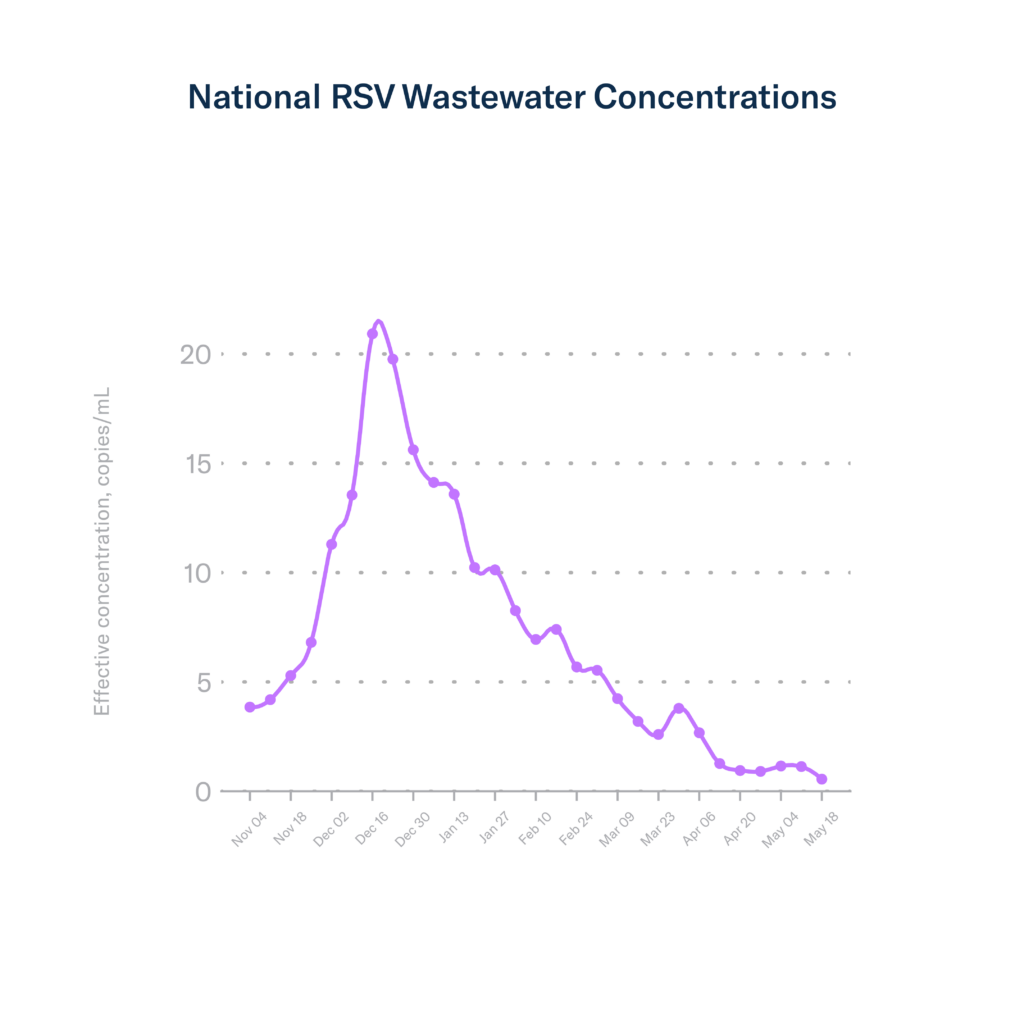
Influenza
Nationally, influenza A & B concentrations declined in week 20, and remain low. We are continuing to keep a very close eye on influenza A concentrations as H5N1 avian influenza is an influenza A virus subtype that our assay picks up. We still haven’t seen any national increases in influenza A, which is great news.
Clinical data showed that the illness burden due to influenza continued to decline in week 19. Test positivity from clinical labs continued to decrease, going from 3.2% to 2.4% currently. The percentage of outpatient visits for influenza-like illness (ILI) – typical in flu, RSV, and COVID-19 patients – held steady in week 19 and remains below the national baseline of 2.9%, currently at 2.0%. FluSurv-NET reports that the influenza hospitalization rate per 100,000 persons declined from 0.4 in week 18 to 0.2 in week 19.
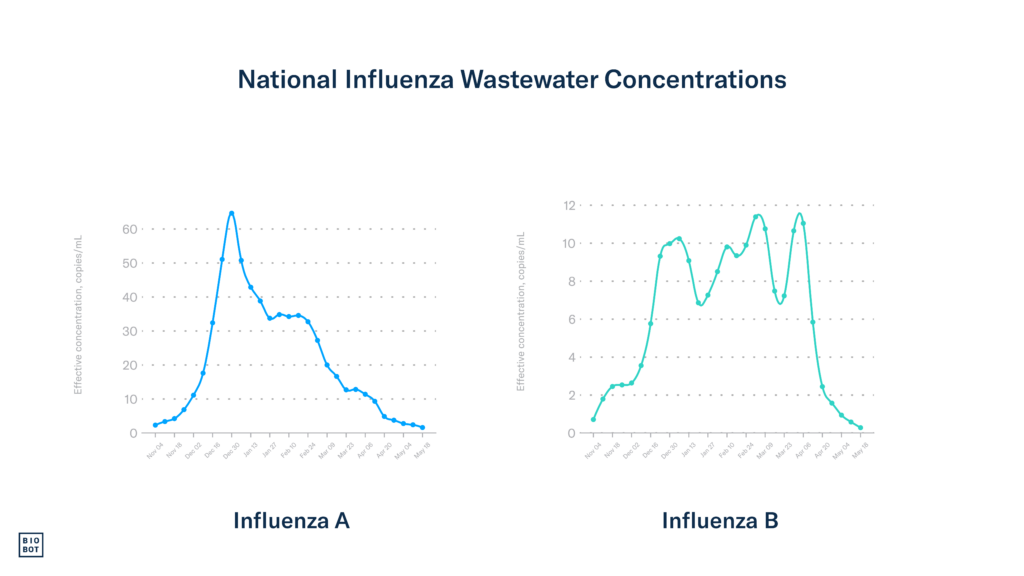
COVID-19
Wastewater data show that COVID-19 activity and community viral load increased during week 20, but remain low overall. The national average SARS-CoV-2 wastewater concentration is 250 copies per mL.
Clinical metrics continue to show low COVID-19 disease burden in week 19. Test positivity held steady in week 19, currently at 3.2%. COVID-NET reports that the hospitalization rate per 100,000 persons declined from 1.0 in week 18 to 0.6 in week 19. Deaths due to COVID-19 slightly declined, and currently represent 0.6% of all deaths in the US.
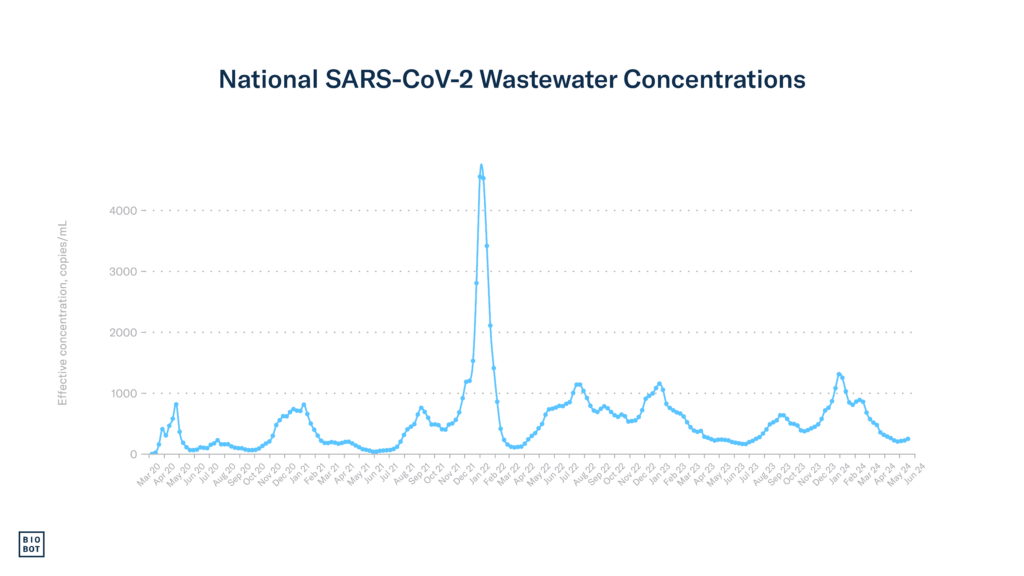
Regional
The South
RSV: In the South, RSV wastewater concentrations declined and remained very low during week 20.
Influenza: We are happy to report that influenza A concentrations have continued to decline in the South through week 20. Influenza B concentrations have also continued to decline and are now at the lowest levels we observed in the South since we began testing. Clinical data continues to confirm that disease burden due to influenza remains low – all Southern states remained in the Minimal ILI activity level through week 19, and none experienced increases in outpatient visits due to ILI.
COVID-19: SARS-CoV-2 wastewater concentrations held steady in the South during week 20, currently at 157 copies per mL. Georgia and Tennessee (the Southern states in COVID-NET) both experienced decreases in COVID-19 hospitalization rates in week 19, and their hospitalization rates remained low overall.
The Midwest
RSV: RSV concentrations continued to decline in the Midwest during week 20, and are currently very low. After a brief, and very small, increase in RSV hospitalization rates in Minnesota during week 18, rates have come back down in week 19. RSV has gone back down to the low levels we expect for this time of year.
Influenza:In good news, wastewater concentrations for influenza A decreased in the Midwest in week 20, after a brief period of slightly elevated levels in weeks 18 and 19. Influenza B wastewater concentrations also declined and remained low in the Midwest during week 20. Clinical data continues to show low influenza illness burden in the Midwest – all states in the Midwest in the Low or Minimal ILI activity levels. Kansas however, experienced a slight uptick in outpatient visits due to ILI, going from 1.08% of visits in week 18 to 1.3% week 19. As alway, we will continue to pay close attention to any fluctuations in influenza activity.
COVID-19: SARS-CoV-2 wastewater concentrations slightly increased in the Midwest during week 20, currently at 225 copies per mL. Michigan, Minnesota, and Ohio (Midwestern states in COVID-NET) all experienced decreases in COVID-19 hospitalization rates in week 19, with their hospitalization rates remaining low overall.
The Northeast
RSV: In the Northeast, RSV wastewater concentrations remained very low during week 20, and are currently the lowest values we’ve observed for the region since we began testing.
Influenza: Influenza A and B concentrations decreased in the Northeast during week 20, and are similar to what they were in early November. In week 19, all Northeastern states remained in the Minimal ILI activity level, and none experienced increases in ILI visits.
COVID-19: SARS-CoV-2 wastewater concentrations slightly increased in the Northeast during week 20, currently at 345 copies per mL. Connecticut, Maryland, and New York (Northeastern states in COVID-NET) either held steady or experienced decreases in hospitalization rates, which remained low across the board in week 19.
The West
RSV: RSV wastewater concentrations remained low in the West during week 20, and are currently the lowest values we’ve observed for the region since we began testing.
Influenza: Wastewater concentrations for influenza A and B remained stable and very low in the West during week 20, and are at similar levels to those observed when we began testing in late October. Clinical metrics also reflect low influenza activity. During week 19, all Western states remained in the Low or Minimal ILI activity levels. Hawaii, however, experienced a slight uptick in outpatient visits due to ILI, going from 2.6% of visits in week 18 to 3.6% week 19.
COVID-19: During week 19, SARS-CoV-2 wastewater concentrations held steady in the West, currently at 240 copies per mL. Western states in COVID-NET including California, Colorado, New Mexico, and Utah experienced decreases in hospitalizations rates in week 19, while Oregon experienced a slight increase. COVID-19 hospitalizations in the West, however, remain low overall.


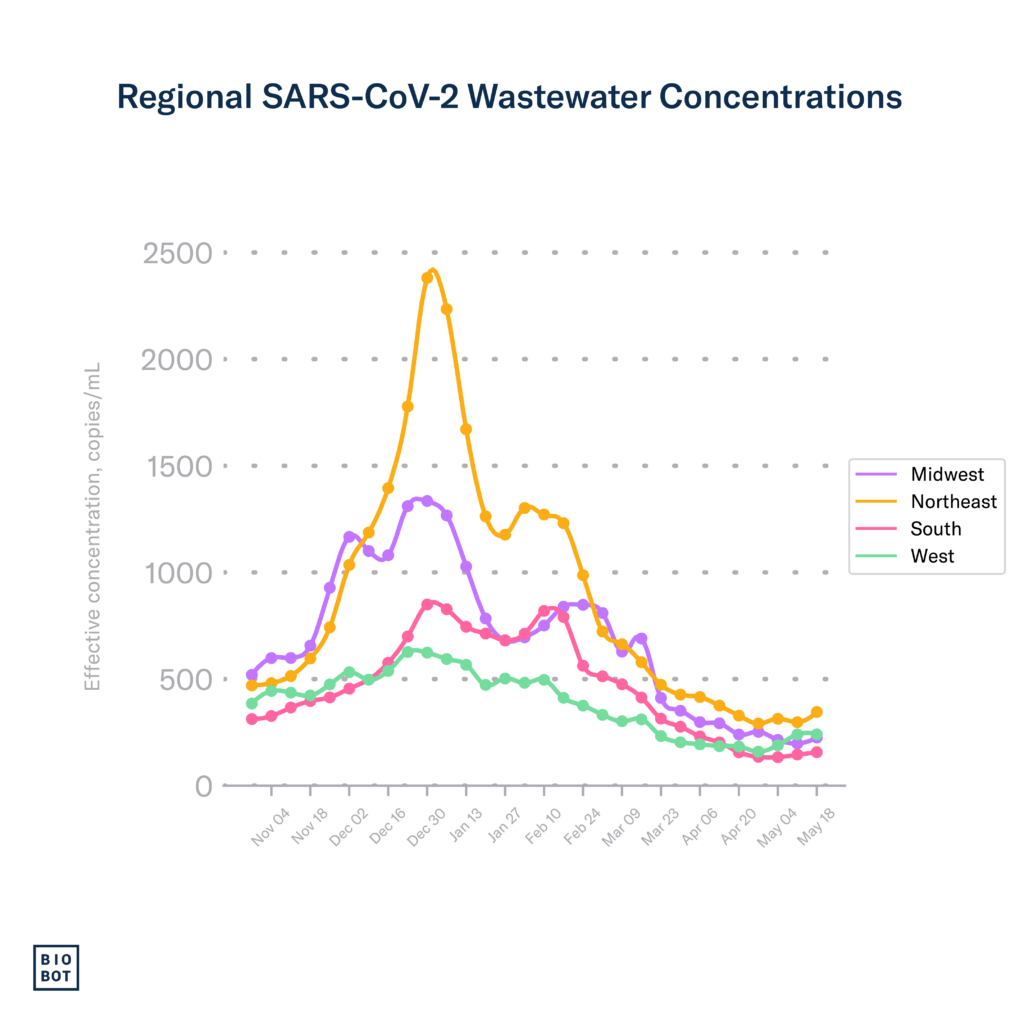
Footnotes:
Wastewater data from Biobot Analytics for RSV, influenza, and SARS-CoV-2 are through May 18, 2024 (MMWR week 20). Clinical data on testing, hospitalizations, and emergency department visits for RSV, influenza, and COVID-19 are from the Centers for Disease Control and Prevention. Updates to clinical data for RSV, influenza, and COVID-19 are through May 11, 2024 (MMWR week 19).




